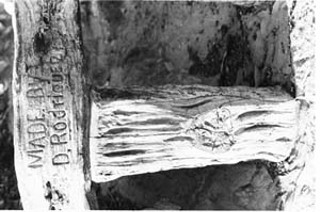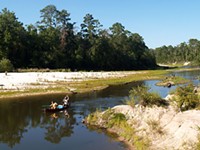Day Trips
Artists have tried to replicate the method of creating cement sculptures that look like wood, but few have mastered the technique like Dionicio Rodríguez
By Gerald E. McLeod, Fri., Feb. 4, 2005

El trabajo rustico died in 1955 with its master. Other artists have tried to replicate the method of creating sculptures out of cement that look like wood, but few have mastered the technique like Dionicio Rodríguez.
Working nearly 30 years in the U.S., the Mexican-born Rodríguez molded cement into the shapes and colors of remarkably realistic-looking wood. Rodríguez spoke no English and was very secretive about his techniques. Although he trained assistants, he never divulged his methods for coloring and shaping the cement in such a realistic fashion.
Possibly, Rodríguez learned his craft while working in a Mexican foundry and later with an Italian artist who made imitation rocks. The sculptures are assembled on a skeleton of iron rods with fast-drying cement used for the outer layer. The artist made his own tools and often worked covered by a tent to keep onlookers from stealing his trade secrets.
Looking close at the designs reveals the astounding detail put into the pieces. The faux bois, or fake wood, includes worm holes, lichen, peeling bark, and notches made by a carpenter's saw. On several works, Rodríguez signed his name on what looks like a small board that includes the heads of nails.
Although he completed commissions all over the U.S., Rodríguez considered San Antonio home and died there in 1955 at the age of 64. The city still possesses some of his finest creations, many of them accessible to the public. Half a dozen of his sculptures were added to the National Registry of Historic Places in 2004.
Brackenridge Park, on San Antonio's north side, contains five projects completed by Rodríguez between 1925 and 1930. One of Rodríguez's first commissions in the city was an arbor footbridge in the park over an acequia, a canal used to irrigate the Spanish mission's fields. Although the wood colors have faded over the years, the bridge (near the intersection of Brackenridge Street and Hildebrand Avenue) has held up remarkably well and is a masterpiece of the artist's delicate techniques. In the field across the street from the bridge is a bench inside a large fake wood tree stump that once stood in Alamo Plaza in downtown.
Rodríguez seems to have had no shortage of work in San Antonio, having completed numerous pieces on public and private property. Across from the zoo's entrance is a thatch-roofed bus shelter that is worn from use but still very functional. Inside the zoo, near the education center, is another bench with a thatched roof done by the artist.
One of Rodríguez's most beautiful accomplishments was the gate to the Japanese Tea Gardens, or "Sunken Gardens" as the locals call it, near the entrance to the zoo. Incredibly detailed, the structure looks like logs holding up a traditional Oriental roof.
The gardens are the original site of the Alamo Cement Company quarry, the first Portland cement plant west of the Mississippi. The original smokestack and kiln are on the hillside next to the gardens. Alamo Cement's president, Charles Baumberger, became an early patron of Rodríguez. He commissioned the arbor bridge and a bus stop shelter at the corner of 4900 Broadway St., a couple of blocks west of the park.
Baumberger changed the company's name and moved the operation to where the Quarry Market is now, north of the park off U.S. 281. A couple of years ago the cement company's headquarters building east of the shopping center was turned into the Stone Werks Cafe & Bar at 7300 Jones-Maltsberger Rd. The fence along the outdoor beer garden is a Rodríguez original that reproduces at least 20 species of tree bark.
Other works by Dionicio Rodríguez can be seen in San Antonio at the Museum of Art, 200 W. Jones Ave., and at St. Anthony of Padua Shrine, 100 Peter Baque Rd. Other works in Texas include a gazebo now at Haven River Inn, 105 FM 473, in Comfort; and at Woodlawn Garden of Memories, 1101 Antoine Dr., in Houston.
Rodríguez's most famous work outside of Texas is a stone gristmill in T.R. Pugh Memorial Park in North Little Rock, Ark. Other pieces can be found in Clayton, N.M.; Memphis, Tenn.; Birmingham, Ala.; Cambridge and Detroit, Mich.; and Brentwood and Suitland, Md.
712th in a series. Day Trips, Vol. 2, a book of Day Trips 101-200, is available for $8.95, plus $3.05 for shipping, handling, and tax. Mail to: Day Trips, PO Box 33284, South Austin, TX 78704.








